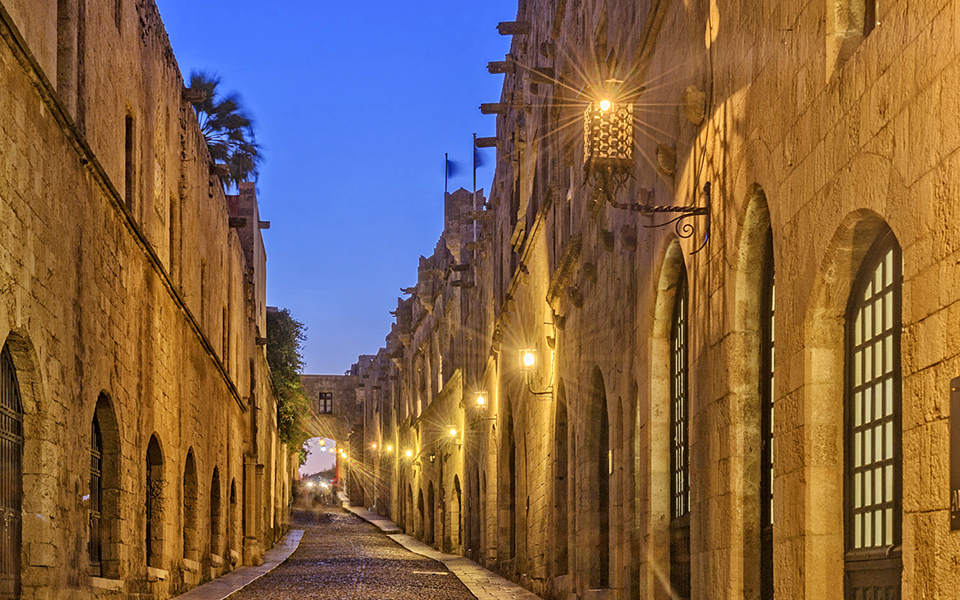Discover the Grande Dame of the Dodecanese with this handy travel guide.
EXPLORE
LIKE A FILM SET: Take a nice long stroll around the Old Town, the medieval district of Rhodes Town, day or night. Enter through one of its 11 gateways and get lost in the narrow alleys of this unique, 420,000-sq.m. city, built by the Knights of Saint John in the 12th century. Restored by the Italians in the early 20th century, it’s still home to some 2,000 residents who just happen to be living in a UNESCO World Heritage Site.
A visit here is amazing; it’s an experience that should not be missed. Stroll along the beautiful Street of the Knights in the knights’ residential quarter of Kollakio, which, in the lamplight of the evening, looks almost like a film set. The once working-class district of Bourgos – home to the Greeks living under the Knights and later to the Turks and Jews under the Ottomans – is much livelier: tourist restaurants, cafés and shops stand side by side with mosques, steam baths and Byzantine churches.
Info
- Area: 1,400 sq. km.
- Population: 115,490 (2011 census)
- Distance: 239 (sea miles from Piraeus)
- Highest Peak: 1,210m (Attavyros)
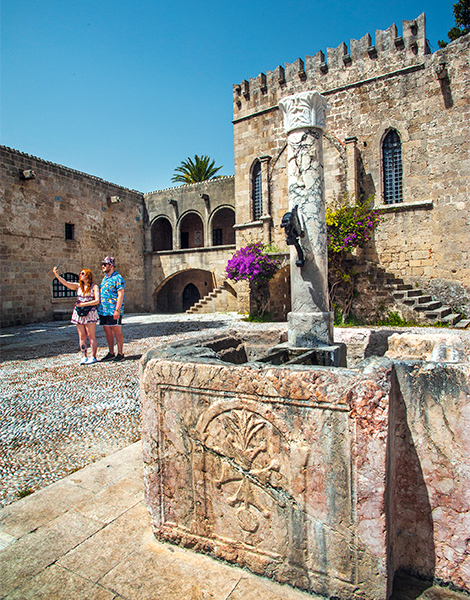
© Clairy Moustafellou
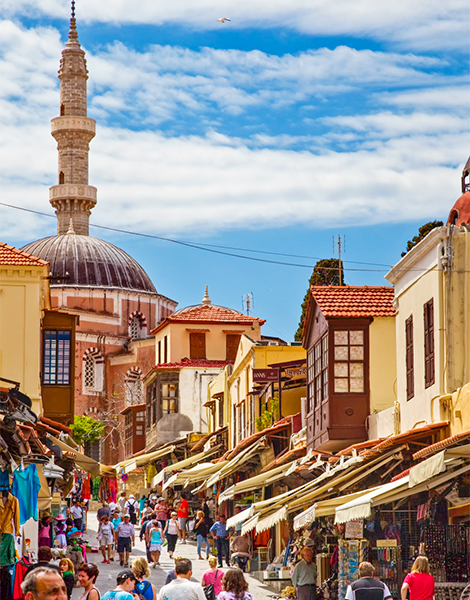
© Perikles Merakos
TRACES OF HISTORY: If you come in through Eleftherias (Freedom) Gate and head to Symis Square, you’ll catch glimpses of a lot of the Old Town’s history, including the ruins of the ancient Temple of Aphrodite and part of a Hellenistic fortification wall; the 11th-c. Panaghia tou Kastrou Church (Tue-Sun 08:00-17:00), with its Gothic additions and coats of arms; the Armory of the Knights, which houses a lovely collection of folk art (Tue-Sun 08:00-17:00); and the Municipal Gallery (Mon-Fri 08:00-15:00), with sculptures and engravings by distinguished Greek artists. The stately home of Hassan Bey, one of the island’s Turkish governors, is a bit further on from here, as is the early 16th-c. Inn of Auvergne, which is now a coffee shop.
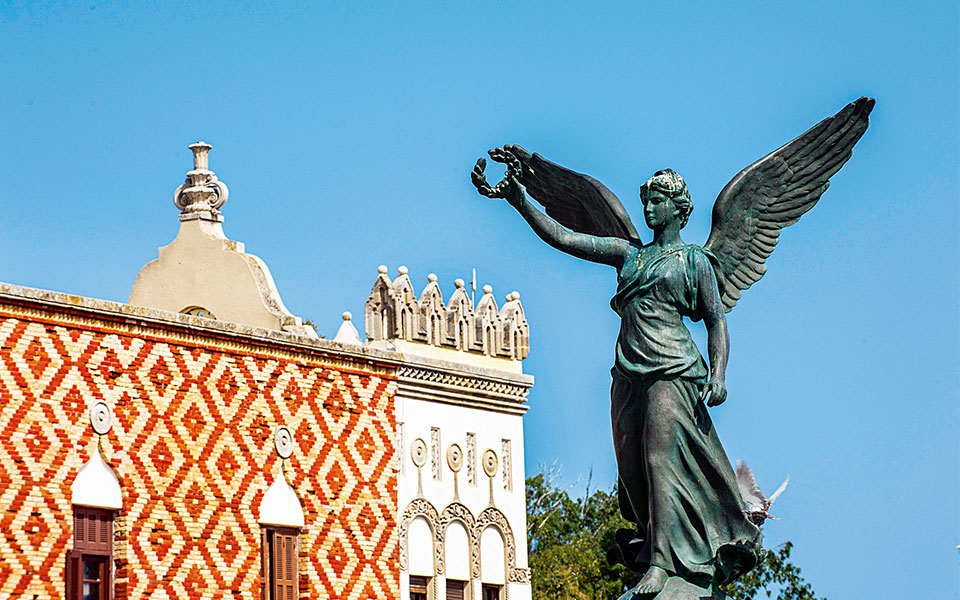
© Clairy Moustafellou
ITALIAN GLORY: Mandraki is the city’s new port; it reflects the Italians’ efforts to interject themselves in Rhodes’ history and to impose their dominance, as they did throughout the Dodecanese. Many of the historic buildings here were constructed at the peak of the Italian occupation, between 1925 and 1939, by Italian architects, in a variety of styles. Key among these – and all located along the coastal stretch – are the Town Hall, the Regional Authority, the National Theater and Evangelismos Church, which was built as a Catholic church in 1926 but which today boasts icons and wall paintings by the Greek master Fotis Kontoglou (1895-1965).
Walk to the end of the jetty for the now-standard tourist photos of the 15th-c. Fortress of Aghios Nikolaos and the two bronze deer, symbols of the island, at the port entrance. A great spot from which to watch the sunset is Monte Smith Hill in the new town; here you can also see the ruins of the Hellenistic acropolis and, at its feet, the stadium and the odeon that were restored by the Italians.
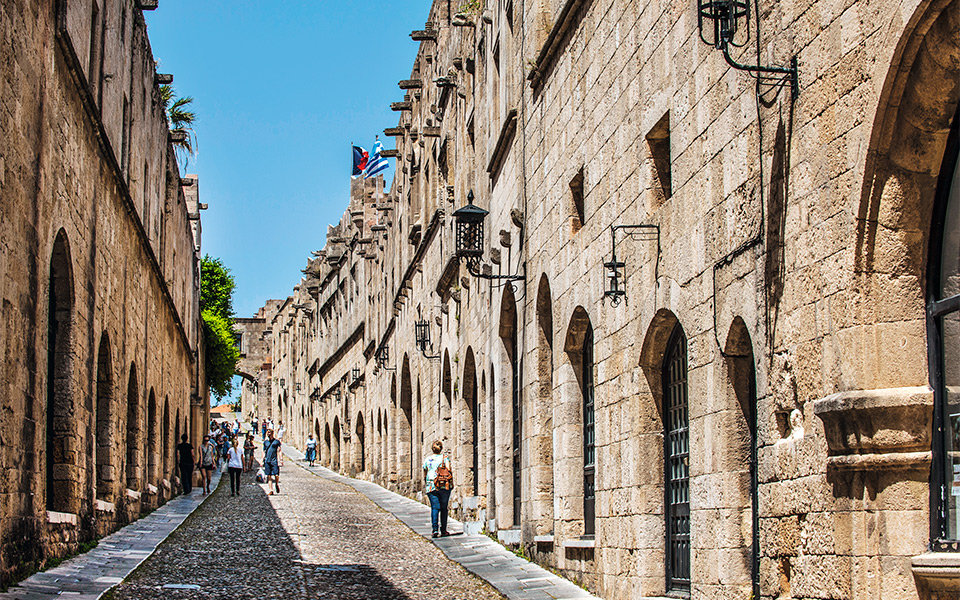
© Clairy Moustafellou
GHOST VILLAGE: A visit to Eleousa, one of the four now-deserted villages established by the Italians as part of a strategic approach to controlling the rural economy, can be an unsettling experience. Originally built in 1935 at the foot of Mt Profitis Ilias (36km from Rhodes Town) to accommodate northern Italian foresters who looked after the woodlands in the area, its notable buildings include the old market house and the Fascist Party headquarters, which were converted into a sanatorium for tuberculosis patients in 1947. (A few meters further ahead, you’ll also come across a huge tank that gathers water from the Kokkinisti spring. This is one of the few habitats of the gizani, a small freshwater fish endemic to Rhodes.)
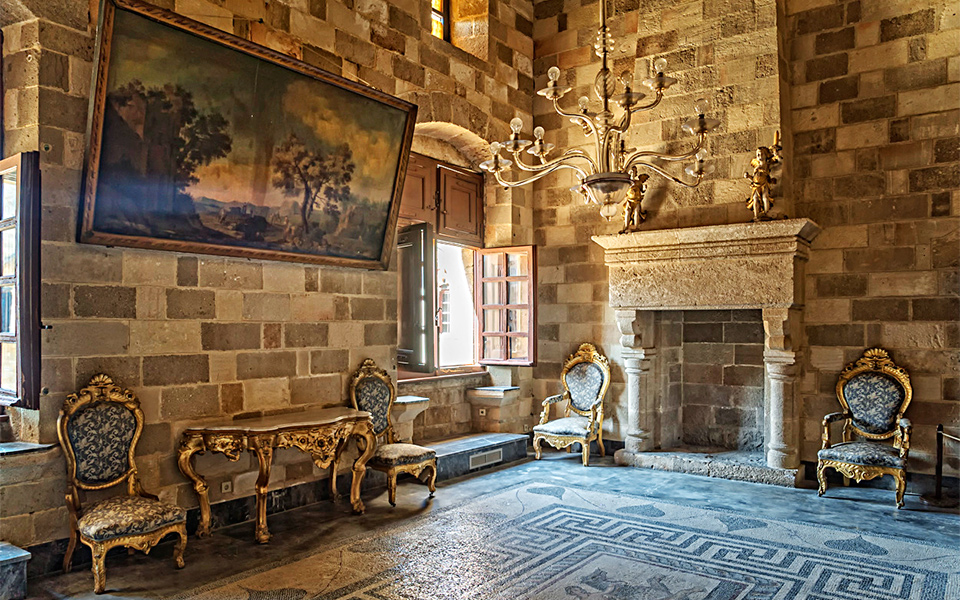
© Perikles Merakos
FOCUS – THE LEGACY OF THE KNIGHTS
The medieval, walled city of Rhodes, with its broad avenues and narrow, labyrinthine alleys, presents one of the most atmospheric settings you can visit in Greece. A strategically-located commercial and military port, Rhodes came under Roman (2nd c. BC) and Byzantine authority (4th c. AD), then was fought over by Arabs, Genoese, Venetians, Crusaders and Ottoman Turks. The Knights of St. John (Hospitallers) left the greatest mark, seizing the port city in 1309 and fortifying it with massive crenelated walls, towers and elegant gateways.
For two centuries, Rhodes served as the seat of the Knights’ Grand Master, headquarters of a multinational Christian garrison and an important hub for merchants and pilgrims. In addition to age-old houses, chapels, mosques and soaring minarets, the city’s major monuments – all wonderfully restored, initially by the Italians – include the Knights’ Hospital (now the Archaeological Museum, open 08:00-20:00), the Palace of the Grand Master (open same hours), the Street of the Knights, the Cathedral of the Latins and the Basilica Mercatorum, a mercantile court where commercial disputes were settled. – John Leonard
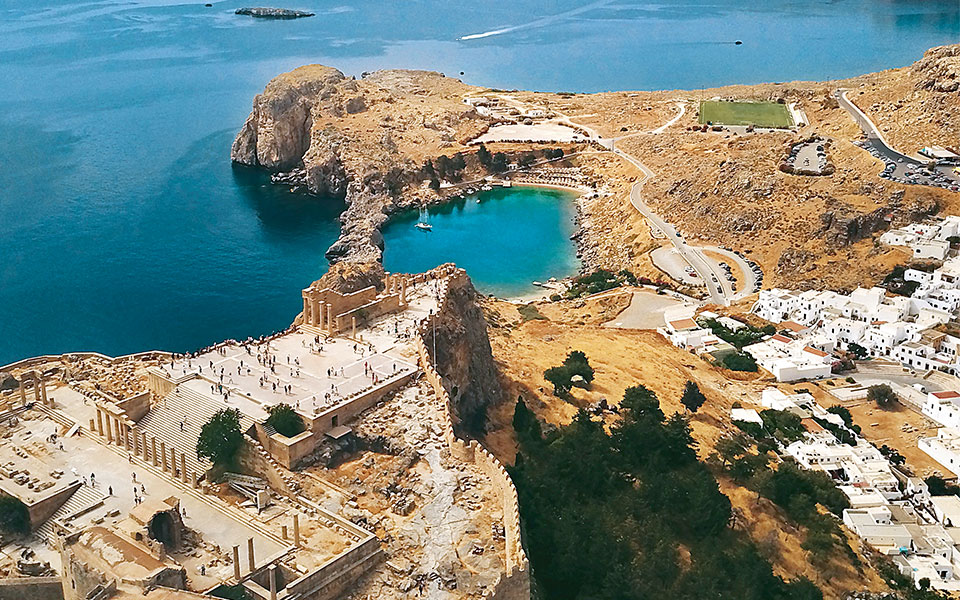
© Costas Spathis, Ministry of Culture and Sports/Ephorate of Dodecanese
FOCUS – LINDOS, THE ETERNAL STAR
The greatest of Rhodes’ Dorian-founded cities, Lindos is a natural phenomenon and major archaeological site that simply knocks your eyes out – its high, steep-sided acropolis flanked by twin natural ports and crowned with a Hellenistic Greek fortress, successively strengthened by the Romans, Byzantines and the Knights of St. John (early 14th c.).
Inside the imposing enceinte with its multiple towers, the hill’s summit originally held a sanctuary of Athena Lindia, adorned with a monumental Doric propylon (entrance-way), amphiprostyle (double-ended) Archaic/Hellenistic temple and stoa (arcade), all now partly reconstructed. Around the citadel’s cliffs and slopes are found elaborate family tombs, a theater with twenty-six tiers of preserved seats and a colonnaded shrine of Dionysus. Also not to be missed are the circular “Tomb of Cleobulus,” apocryphally attributed to Lindos’ great 6th c. BC tyrant/philosopher, and the rock-cut relief of a trireme (ca. 180 BC) that recalls the Lindians’ former maritime power. – John Leonard
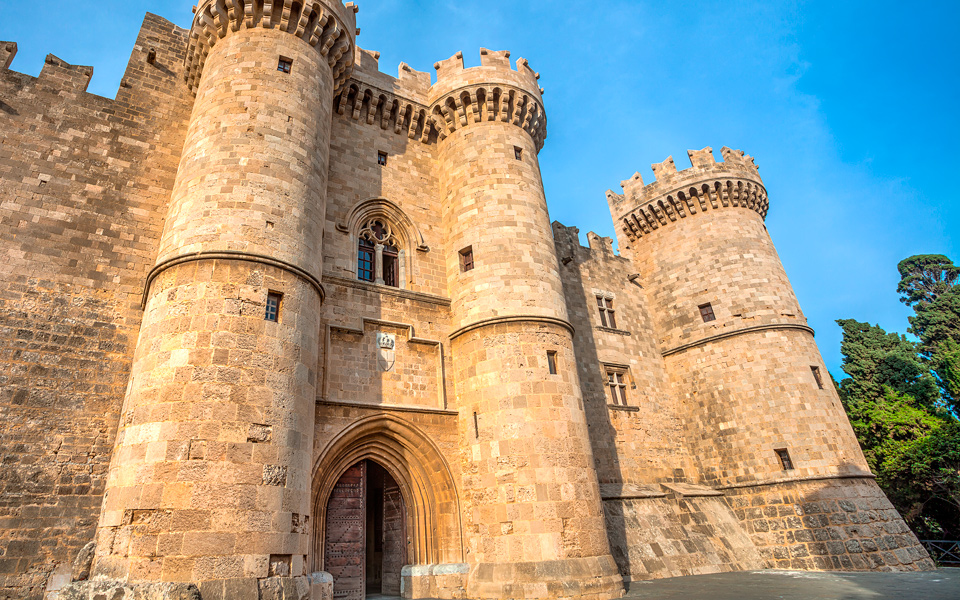
© Shutterstock
EXPERIENCE
VIEWPOINT: If you’re not bothered by the heat (the midday summer temperature on Rhodes often hits the 40°C mark), take a walk along the top of the walls of the Old Town to enjoy the view. The one-way journey, starting at the Palace of the Grand Master, is only permitted from 12:00 to 15:00. It takes 30-40 minutes to reach the gate known as the Red Door in the south end of the Old Town.
SIMPLY CHARMING: Ignore the touts trying to lure you into shops and restaurants surrounding Hippocrates Square and the Square of the Jewish Martyrs and instead make a beeline for Panaghia Bourgou, a beautiful, half-collapsed late Gothic monument from the 14th century. Walk around the quiet narrow streets in this area, under arches and past old houses with enclosed wooden balconies known as sachnisia. The district is full of Byzantine churches, mosques, springs and boutique hotels – it’s a mosaic of human activity. You’ll most likely end up at Arionos Square (the 16th-c. hammam here is slated to reopen soon), where you can sit down for a bite or a drink under the trees.
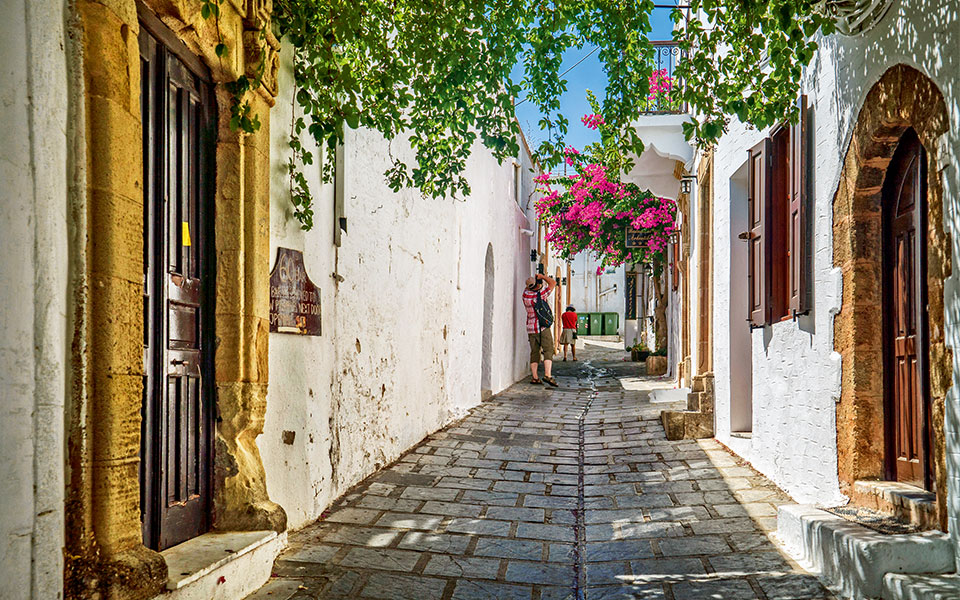
© Perikles Merakos
THE LINDOS EXPERIENCE: Lindos is another great reason to visit Rhodes. The traditional town (55km from Rhodes Town) resembles a charming Cycladic village, while its three beaches and its acropolis-castle are just extra bonuses. Wander around its maze of alleys and look for the white houses known as kamarika – perfect examples of bioclimatic architecture, with skylights and thick stucco-covered walls to stop the heat seeping in – and for the 17th-c. captains’ houses with their entrances made of tuff blocks and their pebble-mosaic floors.
Take the village’s main street and, after a relatively steep 15-minute uphill walk, you’ll come to the ancient city’s acropolis. The best time to visit is in the afternoon. Wrap up your visit with dinner at Mavrikos (Tel. (+30) 22440.312.32) or the restaurant at the Melenos Lindos Hotel (Tel. (+30) 22440.322.22), followed by cocktails at the bar on Aghios Pavlos Beach in St Paul’s Bay.
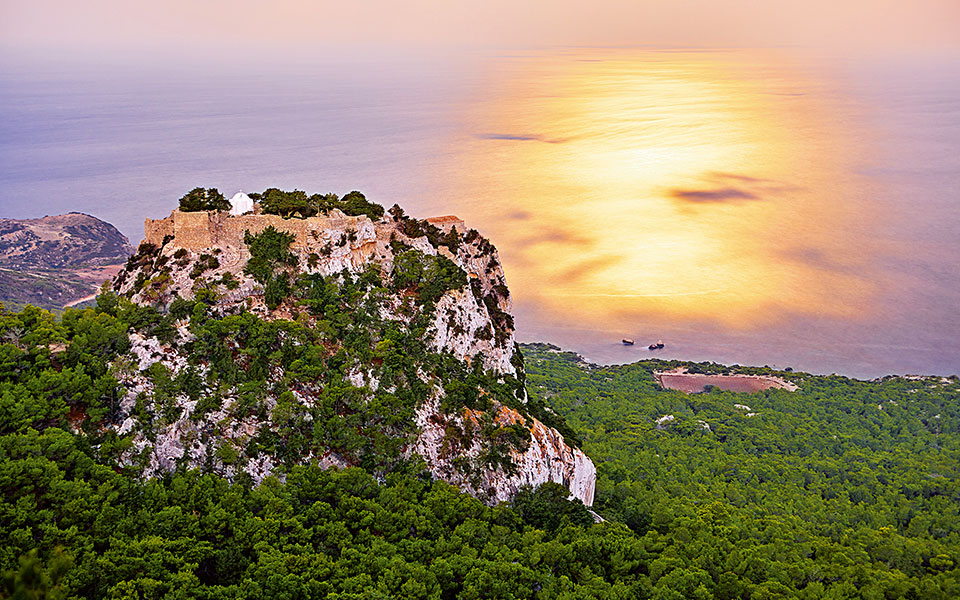
© George Tsafos
SUNSET CASTLES: A walk in the golden light of the setting sun is amazing at either Monolithos Castle or Kritinia Castle, both part of the defensive fortifications constructed during the Middle Ages. The latter hosts various cultural events over the summer, including something special during the August full moon, so you might want to hang around for the show. If you get hungry, the nearby café-taverna Mylos is a local favorite.
MOUNTAIN HAVEN: Cool temperatures, great views and a thick pine forest − in other words, everything one can expect from a mountain resort awaits you on Rhodes as well. Built on the slopes of Mt Profitis Ilias in the early 1930s and styled after the chalets of northern Italy, the two mountain lodges Elafos and Elafina (meaning “buck” and “doe,” respectively) were named in honor of the fallow deer that live in this forest. Their initial purpose was to host officials who visited the island. Elafos has been restored and now operates as a hotel and café; it’s quite popular with locals, especially in the winter. You can get here by car, or on foot following a 9km mountain route from Eleousa. If you choose to walk, you’ll see the 15th-c. four-apse Chapel of Aghios Nikolaos Fountouklis along the way.
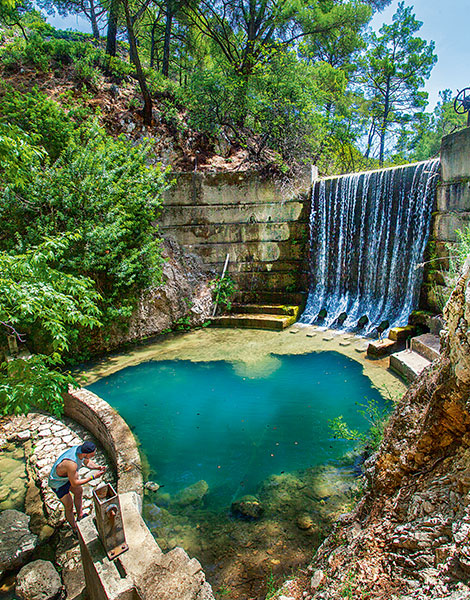
© Clairy Moustafellou
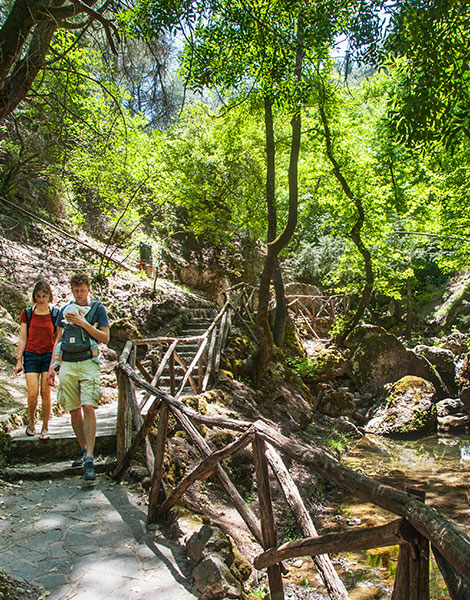
© Getty Images/Ideal Image
SPRING OF LIFE: Another great place to hide from the summer heat at midday is Epta Piges (“Seven Springs”), 26km from Rhodes Town. In this ravine crowded with plane trees, water gushes from seven different sources. The (literally) coolest thing you can do here is to take off your shoes and wade through the dark 150m-long tunnel that channels the water into a small artificial lake.
LITTLE WINGS: The 1km-walk through the verdant Valley of the Butterflies makes for an enchanting experience. During the summer, this is the resting place of the Panaxia quadripunctaria, a member of the Jersey Tiger moth family that looks very much like a butterfly. They gather in great numbers here along the banks of the Pelekanos River, 25km from Rhodes Town. You’ll see them on rocks, tree trunks, leaves and branches rather than in the air: the moths are nocturnal and sleep during the day, conserving their energy. Observe them in silence, and stick to the designated paths so as to not disturb them. There are also cafés and souvenir shops. Open daily 8:30-17:30.
LAKE ACTIVITIES: Rhodes even has a lake, created in the late 1980s by the construction of a dam outside the village of Apolakkia in order to meet the irrigation needs of the area. It’s a good place to look for the elusive fallow deer of Rhodes. This year, a company has begun offering outdoor activities in the area, including Flying Fox rides, kayaking and archery; it leads other activities elsewhere on the island as well. (Rhodescape, Tel. (+30) 693.937.2584)
THE FILERIMOS ASCENT: The incessant mating calls of male peacocks that roam free on this hill, located 15km southwest from Rhodes Town, will accompany your ascent to the 14th-c. Monastery of Kyra tou Filerimou (Our Lady of Filerimos). Around this restored Gothic structure, dedicated to the Virgin Mary, you’ll see the ruins of an ancient temple of Athena and the remains of an early Christian church. At the base of the hill, take the Path of Golgotha, a flagstone footpath with 14 sculpted Stations of the Cross, which will lead you to a massive cross and an unobstructed view over much of the island and, in the distance, the Turkish coast. The monastery is open daily from 8:00-20:00.
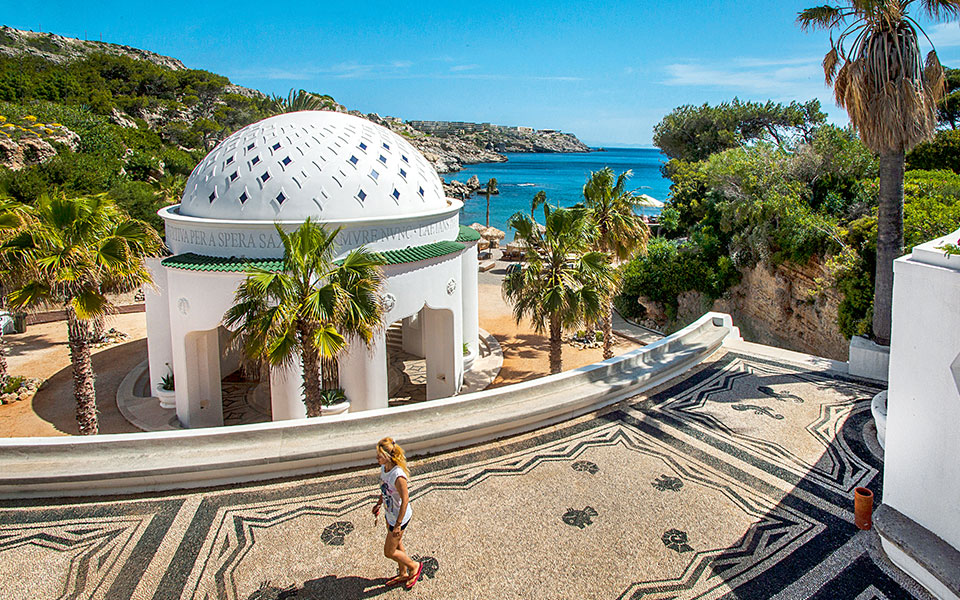
© Clairy Moustafellou, Ministry of Culture and Sports/Ephorate of Dodecanese
OLD-WORLD RETREAT: Designed by the architect Pietro Lombardi and built by the Italians in 1929, the luxurious facilities of Kallithea Springs, located 9km from Rhodes Town, have been attracting crowds of visitors ever since. Now restored to their former glory, the grounds make for an idyllic setting, with two rotundas (the bigger one boasting a 14m dome), flower-covered pergolas, a patio and even a fountain with a figure of Eros. Kallithea Springs often hosts art exhibitions and other events. You can enjoy a swim at its beach and then round off the evening with a drink or a light meal at the pretty café on the waterfront. Open 08:00-20:00 (www.kallitheasprings.gr).
ART STOPS: If you’re interested in local arts and crafts, it’s worth stopping by the Artistic Village, a multi-purpose space run by a family of artists who create ceramics, paintings, and decorative objects made out of iron, glass, wood and other materials, as well as jewelry items. You can watch the artists at work and shop as well (Afantou, 23rd km, Rhodes-Lindos Road, www.artisticvillage.gr). Equally interesting and less commercial is the Art Park outside the village of Archipoli (33k from Rhodes Town), where owner Damon Papakiriakou, a painter, sculptor and musician, invites artists from Greece and other parts of the world to draw inspiration from the natural environment and create new work here. You might see some of these guests as you visit the park’s permanent sculpture and painting collection or browse through the temporary exhibits. (Tel. (+30) 6972.815.547)
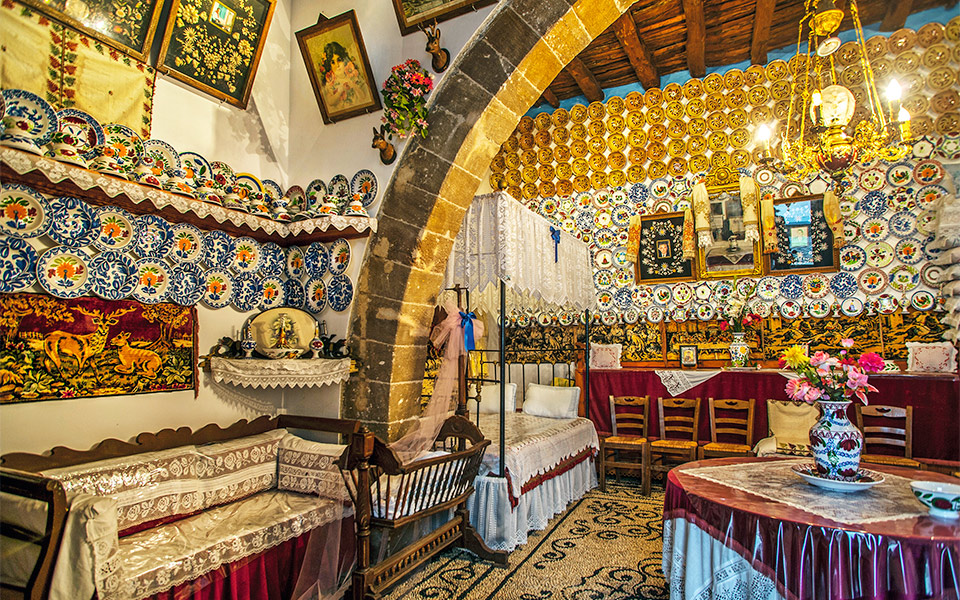
© Clairy Moustafellou
HOUSE OF PLATES: cobbled alleys and brightly colored houses featuring architecture elements such as pyliones (large limestone doorframes), flower-filled patios and pebbled floors greet those who visit the village of Koskinou, just 7km from Rhodes Town. At the Koskinou Traditional House, built in 1902, you can admire an impressive piatelotichos – a large wall covered with typical decorative plates from the island (Open daily 08:00-13:00).
SOUTHERN BELLES: There are two perfectly good reasons to travel the 70km from Rhodes Town to Lachania on the southeastern part of the island. One is the long beach nearby, largely free of sun loungers and umbrellas, where you can enjoy the sea in relative solitude (there’s a more developed part with a laid-back beach bar as well). The other is the picturesque village itself, which has been brought back to life, mostly by non-Greeks who took on the task of restoring its empty houses. The alleys are well kept, the main square features an Ottoman fountain from 1703, and the Platanos Taverna is famous for its perfect version of the simplest of dishes: eggs with fries, located next to an enormous plane tree as well as the 19th-c. Aghios Georgios Church. A few kilometers further south, after Plimmiri Beach, you can make a left turn to the secluded beaches of Aghios Georgios and Mavros Kavos, which boast fine sand, shallow waters and shade provided by a row of cedars. You will, however, need an off-road vehicle and plenty of water.
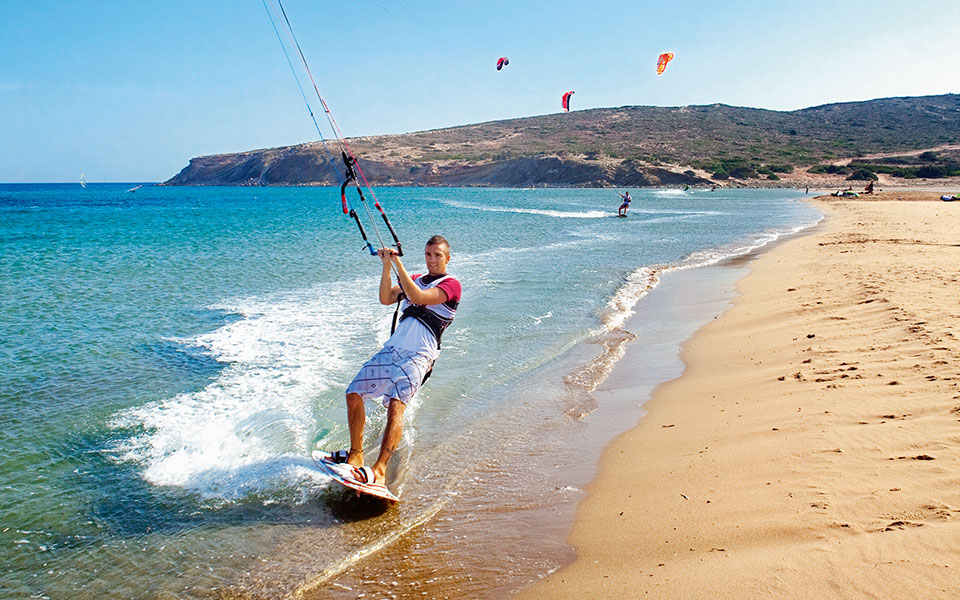
© Perikles Merakos
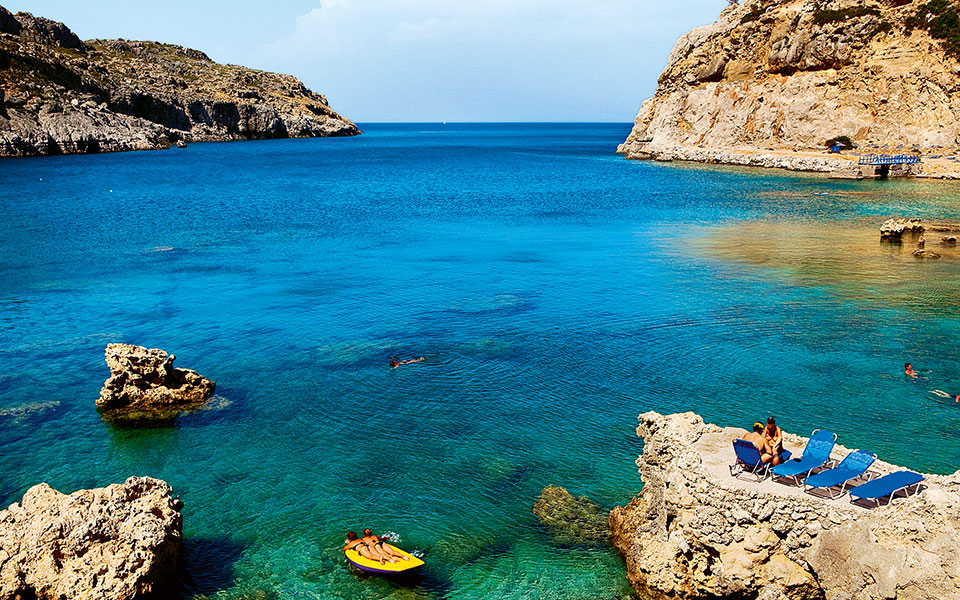
© Perikles Merakos
GONE WITH THE WIND: Located at Rhodes’ southernmost end, 100km from Rhodes Town, Prasonisi is one of the most famous windsurfing and kite-surfing beaches in Europe. An islet during the high tides of winter, during the summer it is connected to the mainland by a sandbar that creates two distinct bays with different surfing conditions. There are several surfing schools on the beach.
BEACHES GALORE: With a 253km coastline, Rhodes offers plenty of variety. Some people prefer rocky coves where they can dive off boulders or outcroppings, while others opt for the long stretches of sand, with endless rows of colorful umbrellas and sun loungers. One of the island’s most popular beaches is the picturesque Anthony Quinn Beach, on the east coast, named for the star of the 1961 war film The Guns of Navarone which was shot in Rhodes. It’s not very large and it gets crowded, so be sure to get here early. If you have children, Agathi Beach on the east coast is perfect; it has warm, shallow waters, fine soft sand, snack bars and a pretty view of Faraklo Castle. A similar setting, though minus the castle, can be found at Tsambika Beach. For more peace and quiet head to either Fourni Beach, with coarse sand and pebbles, and a few small caves begging to be explored, or to Kritikos Beach, both on the southwest coast.
MINI THRILL: Throw yourself off the “Trampoline,” the name that the locals have given to a cement diving platform standing in the middle of the water off the town’s main beach. One of several iconic structures on the island, it was built by the Italians in the 1930s and restored in 2007.
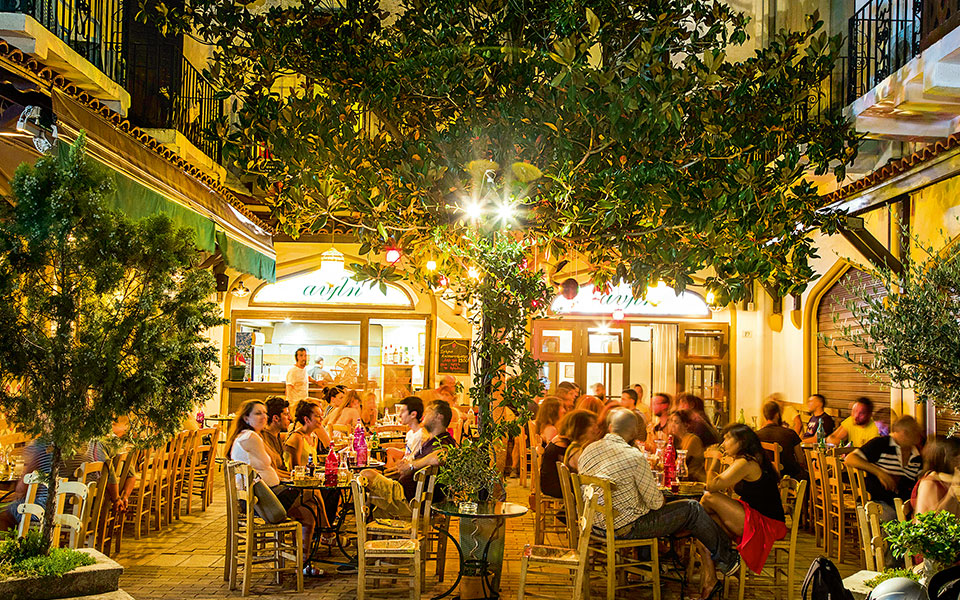
© Perikles Merakos
TASTE
WINE: Rhodes was one of the first Greek islands to engage in the cultivation of grapes and has a long history in winemaking. Its main native grape varieties are Mandilaria (known here as Amorgiano) and Athiri. The island’s wine industry is intrinsically linked to CAIR, a company established in 1928 by Italian investors and owned by the Dodecanese Association of Agricultural Cooperatives since 1957. This winery kept grape cultivation alive through WWII and later became wildly popular as a sparkling wine producer. For several years now, they’ve been focusing on quality still wines as well, such as the Rodos 2400, launched in 1992 to celebrate 2,400 years since the founding of Rhodes Town.
Rhodes’ other big producer is Emery, founded in 1923 and now run by the third generation of the Triantafillou family. Its winery – one of the biggest in Greece – is located in the village of Embonas. There are, in addition, a few small artisanal wineries in Rhodes, such as Alexandris, Kounakis, Tatakis and Mercouri. Make sure to try the island’s two Protected Designation of Origin wines: PDO Rhodes and PDO Muscat of Rhodes.
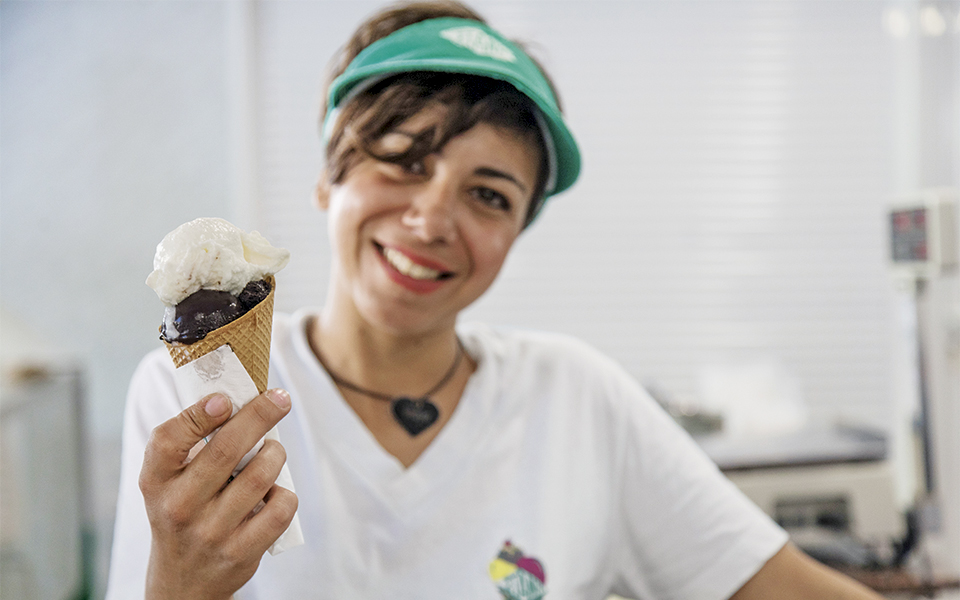
SWEET TREATS: The Beekeeping Company of the Dodecanese in Pastida (15km from Rhodes Town) is a pretty great place, not just for honey, sweets like melekounia (sesame-honey snaps) and other related products, but also for its lovely Bee Museum (Mon-Sat 08:30-17:00, Sun 09:00-13:00, beemuseum.gr) showcasing the island’s lengthy tradition in beekeeping.
Buy fresh rustic bread, melekounia, modern woven textiles and fruit preserves from Apolloniatises, the Women’s Cooperative of the village of Apollonas, which also has a store in Rhodes Town (68 Aghiou Pavlou). Stani (28 Aghias Anastasias), also in Rhodes Town, has amazing ice cream, among other treats.
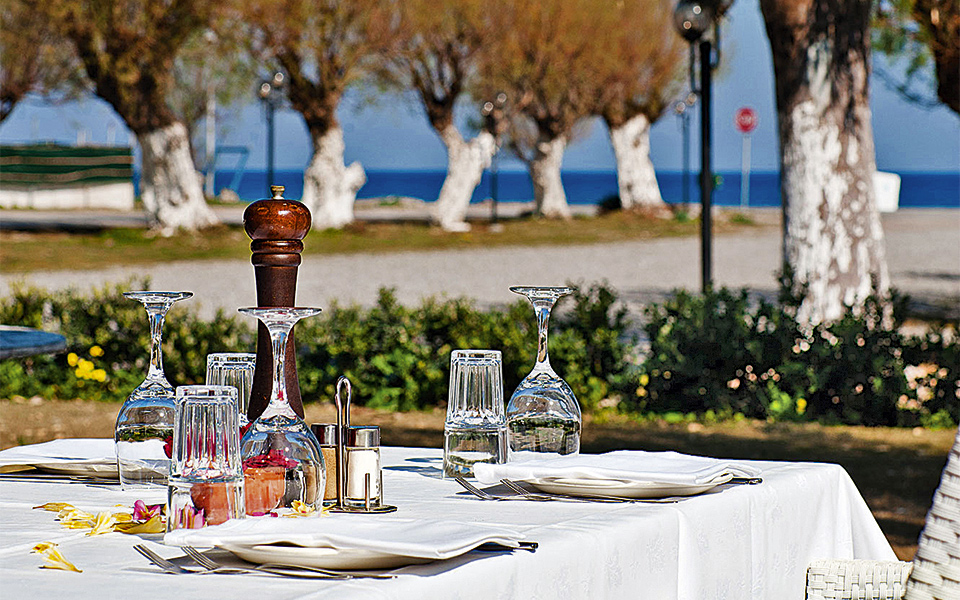
SEASIDE RESTAURANTS: Right at the far end of Stegna Beach on the eastern coast, there’s a taverna called Perigiali, with tables set in the shade of mulberry and fig trees, where you can enjoy rosetia, a cheap snapper-type fish pan-fried and served with a thick garlic sauce. For a hearty meal after your swim, head east to Afantou. One of the best tavernas for fresh fish and seafood here is Avantis, famed for its lobster spaghetti. At the village of Kiotari, Petalas Restaurant puts the focus on its ingredients and presents a creative take on traditional classics like squid ink risotto, octopus with green beans and other such delights.
HIGHLAND TREATS: The mountain village of Apollonas (53km from town) is home to the excellent taverna Paranga, one of just a handful of places on Rhodes where you can still find well-executed traditional dishes. Local cheeses and fresh bread are just a prelude to beautifully executed rustic dishes like goat stifado (an onion-heavy stew) and kapama (stuffed young goat or lamb), all cooked in the wood-fired oven and served in clay dishes. The village of Embonas (55km from town), is where the locals go for grilled and spit-roasted meats, favoring the taverna Adelfia Baki.
IN-TOWN DINING: Good food that includes both meat and fish can be found in the Old Town of Rhodes in the lovely courtyards of Dinoris (14 Mouseio Square) and the Marco Polo Mansion Hotel (40-42 Aghiou Fanouriou). In the new town, get a souvlaki to go from Kellides (96 28th Oktovriou). Every ingredient – from the pita bread to the pork and the tzatziki flecked with fresh parsley – is delicious.

